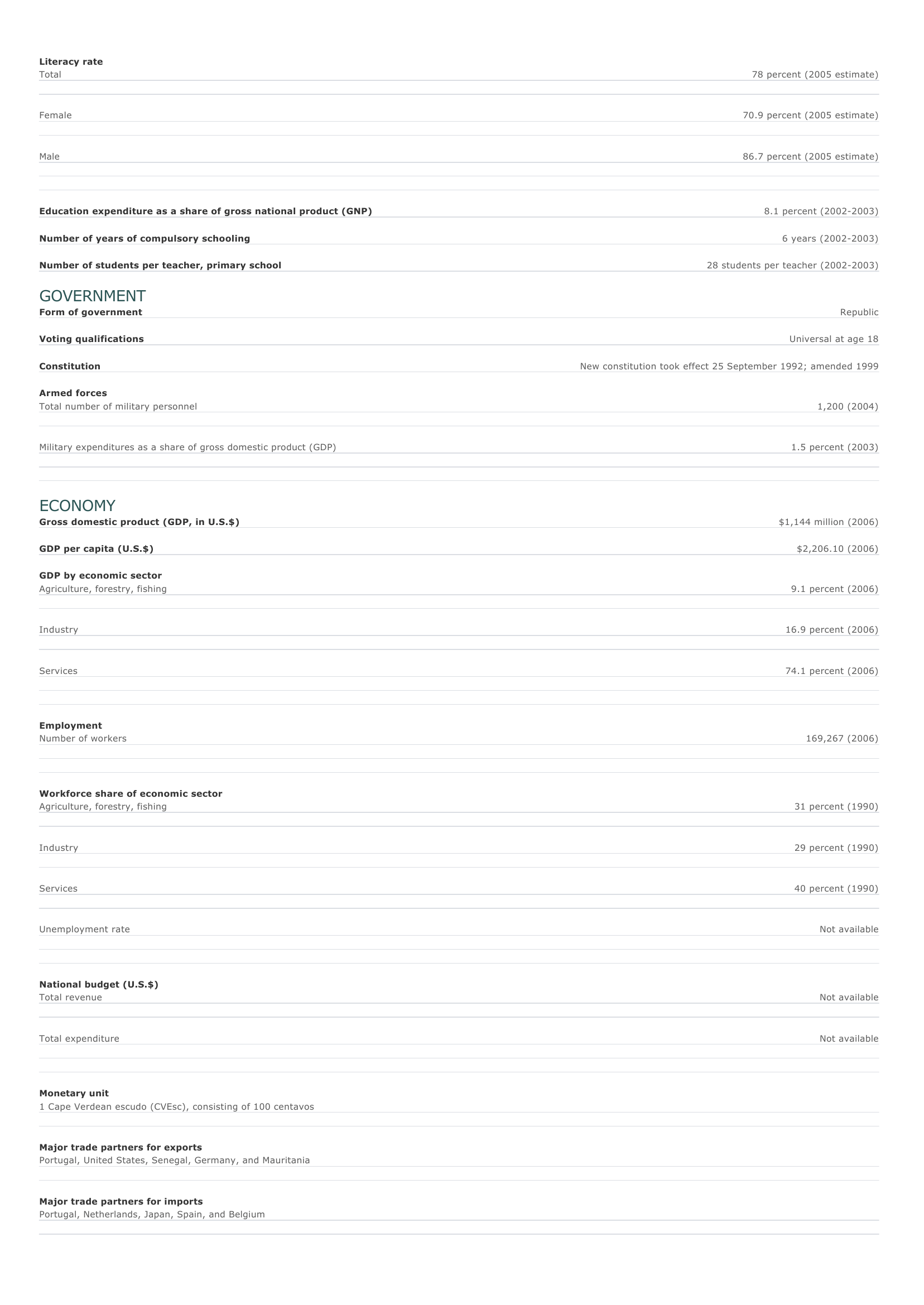Cape Verde Facts and Figures. BASIC FACTS Official name Capital Area Republic of Cape Verde Praia 4,033 sq km 1,557 sq mi PEOPLE Population 426,113 (2008 estimate) Population growth Population growth rate 0.57 percent (2008 estimate) Projected population in 2025 451,021 (2025 estimate) Projected population in 2050 380,614 (2050 estimate) Population density 106 persons per sq km (2008 estimate) 274 persons per sq mi (2008 estimate) Urban/rural distribution Share urban 57 percent (2005 estimate) Share rural 42 percent (2005 estimate) Largest cities, with population Praia 107,000 (2003 estimate) Ethnic groups Creole 71 percent African 28 percent European 1 percent Languages Portuguese (official), Crioulo (a blend of Portuguese and West African words) Religious affiliations Roman Catholic 95 percent Muslim 3 percent O ther 2 percent HEALTH AND EDUCATION Life expectancy Total 71.3 years (2008 estimate) Female 74.7 years (2008 estimate) Male Infant mortality rate Population per physician Population per hospital bed 68 years (2008 estimate) 44 deaths per 1,000 live births (2008 estimate) 2,048 people (2004) 632 people (1992) Literacy rate Total 78 percent (2005 estimate) Female 70.9 percent (2005 estimate) Male 86.7 percent (2005 estimate) Education expenditure as a share of gross national product (GNP) Number of years of compulsory schooling Number of students per teacher, primary school 8.1 percent (2002-2003) 6 years (2002-2003) 28 students per teacher (2002-2003) GOVERNMENT Form of government Republic Voting qualifications Universal at age 18 Constitution Armed forces Total number of military personnel Military expenditures as a share of gross domestic product (GDP) New constitution took effect 25 September 1992; amended 1999 1,200 (2004) 1.5 percent (2003) ECONOMY Gross domestic product (GDP, in U.S.$) GDP per capita (U.S.$) GDP by economic sector Agriculture, forestry, fishing $1,144 million (2006) $2,206.10 (2006) 9.1 percent (2006) I ndustry 16.9 percent (2006) Services 74.1 percent (2006) Employment Number of workers 169,267 (2006) Workforce share of economic sector Agriculture, forestry, fishing 31 percent (1990) I ndustry 29 percent (1990) Services 40 percent (1990) Unemployment rate Not available National budget (U.S.$) Total revenue Not available Total expenditure Not available Monetary unit 1 Cape Verdean escudo (CVEsc), consisting of 100 centavos Major trade partners for exports Portugal, United States, Senegal, Germany, and Mauritania Major trade partners for imports Portugal, Netherlands, Japan, Spain, and Belgium ENERGY, COMMUNICATIONS, AND TRANSPORTATION Electricity production Electricity from thermal sources 100 percent (2003 estimate) Electricity from hydroelectric sources 0 percent (2003 estimate) Electricity from nuclear sources 0 percent (2003 estimate) Electricity from geothermal, solar, and wind sources 0 percent (2003 estimate) Number of radios per 1,000 people 183 (1997) Number of telephones per 1,000 people 141 (2005) Number of televisions per 1,000 people 4.9 (2000 estimate) Number of Internet hosts per 10,000 people Daily newspaper circulation per 1,000 people Number of motor vehicles per 1,000 people Paved road as a share of total roads 1.4 (2003) Not available 11 (1997) 69 percent (2000) SOURCES Basic Facts and People sections Area data are from the statistical bureaus of individual countries. Population, population growth rate, and population projections are from the United States Census Bureau, International Programs Center, International Data Base (IDB) (www.census.gov). Urban and rural population data are from the Food and Agriculture Organization (FAO) of the United Nations (UN), FAOSTAT database (www.fao.org). Largest cities population data and political divisions data are from the statistical bureaus of individual countries. Ethnic divisions and religion data are largely from the latest Central Intelligence Agency (CIA) World Factbook and from various country censuses and reports. Language data are largely from the Ethnologue, Languages of the World, Summer Institute of Linguistics International (www.sil.org). Health and Education section Life expectancy and infant mortality data are from the United States Census Bureau, International Programs Center, International database (IDB) (www.census.gov). Population per physician and population per hospital bed data are from the World Health Organization (WHO) (www.who.int). Education data are from the United Nations Educational, Scientific and Cultural Organization (UNESCO) database (www.unesco.org). Government section Government, independence, legislature, constitution, highest court, and voting qualifications data are largely from various government Web sites, the latest Europa World Yearbook, and the latest Central Intelligence Agency (CIA) World Factbook. The armed forces data is from Military Balance. Economy section Gross domestic product (GDP), GDP per capita, GDP by economic sectors, employment, and national budget data are from the World Bank database (www.worldbank.org). Monetary unit, agriculture, mining, manufacturing, exports, imports, and major trade partner information is from the statistical bureaus of individual countries, latest Europa World Yearbook, and various United Nations and International Monetary Fund (IMF) publications. Energy, Communication, and Transportation section Electricity information is from the Energy Information Administration (EIA) database (www.eia.doe.gov). Radio, telephone, television, and newspaper information is from the United Nations Educational, Scientific and Cultural Organization (UNESCO) database (www.unesco.org). Internet hosts, motor vehicles, and road data are from the World Bank database (www.worldbank.org). Note Figures may not total 100 percent due to rounding. Microsoft ® Encarta ® 2009. © 1993-2008 Microsoft Corporation. All rights reserved.











